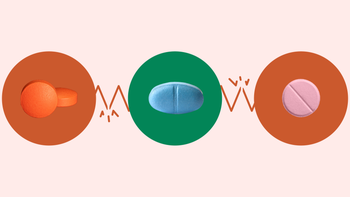
Which Pain Reliever Is Best for Back Pain?
Key takeaways:
Many adults have back pain, and there are a lot of different causes.
Most of the time, acute back pain improves on its own. Long-term back pain can be trickier to live with and manage.
If you need medication, nonsteroidal anti-inflammatory drugs (NSAIDs) are the best first-choice treatment.
Access savings on related medications
Table of contents
Back pain is common. And there are many causes for back pain, from a simple muscle strain to more serious medical emergencies. Acute back pain refers to pain in your back that has been around fewer than 4 weeks. For many people, acute back pain from a musculoskeletal problem often gets better without medications or other treatments. But some people aren’t as lucky. In certain cases, back pain can become chronic (long term).
If you have acute back pain that’s affecting your life, there are medications that can help. Nonsteroidal anti-inflammatory drugs (NSAIDs), with or without muscle relaxants, help people the most.
Best over-the-counter pain relievers for back pain
NSAIDs are the best over-the-counter (OTC) pain relievers for back pain. When you notice pain in your back, your body’s inflammatory system is active in that area. NSAIDs work by lowering inflammation, which in turn decreases back pain.
Search and compare options
Best for fast back pain relief: Ibuprofen (Advil, Motrin)
Ibuprofen (Advil, Motrin) is an NSAID. NSAIDs work by decreasing pain and inflammation. Ibuprofen is available as branded medication and as a lower-cost generic.
Dosage
Most OTC ibuprofen comes in 200 mg tablets and capsules. The typical OTC ibuprofen dosage is 1 to 2 pills by mouth every 4 to 6 hours. The maximum OTC dosage is 6 pills (1,200 mg) in 24 hours.
Precautions and side effects
Anyone with kidney disease needs to talk with a healthcare professional before taking NSAIDs.
It’s important to stay well hydrated while taking NSAIDs.
NSAIDs aren’t good medications for people with stomach ulcers, heart failure, or if you’ve had a heart attack.
Always check with a healthcare professional before starting an NSAID.
Prescription strength available?
Yes, prescription-strength ibuprofen is available in 400 mg, 600 mg, and 800 mg tabs. This can lower the number of pills that you need to take. For example, one 800 mg tab is equally effective to taking four 200 mg tabs.
Best for all day/night back pain relief: Naproxen (Aleve)
Naproxen (Aleve) is another NSAID. It works by decreasing inflammation, similar to ibuprofen. But its effects last longer than ibuprofen, so you don’t have to take it as often throughout the day. Naproxen is available as branded medication and as a lower-cost generic.
Medication isn’t the only answer for back pain. Massage therapy is a good nonmedication option for many.
What does it actually mean to “throw your back out?” Learn more about this common back injury.
Did you know walking is good for back pain? Here are some tips on how to get moving when your back is hurting.
Dosage
Naproxen is available OTC as a 220 mg tablet and capsule. A typical OTC naproxen dosage is 220 mg by mouth every 8 to 12 hours. The maximum OTC dosage is 3 pills (660 mg) in 24 hours. You shouldn’t take more than 2 pills (440 mg) in a 12-hour period.
Precautions and side effects
Aleve side effects are mostly the same as those of ibuprofen. You’ll want to check with a healthcare professional if you’ve had a heart attack or if you have heart failure. Also, watch out for:
Kidney disease
Dehydration
Stomach ulcers
Prescription strength available?
Yes, prescription-strength naproxen is available in high-dose tablets (250 mg to 750 mg). Naproxen is also available in 375 mg and 500 mg delayed-release tabs as well as extended-release tablets, ranging from 375 mg to 750 mg.
Best for back pain relief if you can’t use NSAIDs: Acetaminophen (Tylenol)
Acetaminophen (Tylenol) decreases pain and lowers fevers. Researchers don’t exactly understand how acetaminophen works. It affects different paths in the brain that help with pain and temperature. Acetaminophen is available as branded medication and as a lower-cost generic.
Dosage
A typical OTC tablet of acetaminophen is:
325 mg (regular strength)
500 mg (extra strength)
650 mg (extended release)
The typical and maximum dosage depends on the specific product. But, in general, you shouldn’t take more than 3,000 mg to 4,000 mg of acetaminophen per day.
Precautions and side effects
Taking more than the recommended amount of acetaminophen can cause liver injury and other side effects. This includes acetaminophen from all sources, like OTC cold medications and prescription pain relievers. So it’s important to make sure that you aren’t getting more than the maximum dose from all of your sources put together.
Prescription strength available?
Certain medications that have acetaminophen require a prescription. But the FDA limits the amount of acetaminophen in these products to 325 mg per dose.
Best prescription back pain relievers
If OTC NSAIDs don’t provide relief, there are prescription options you can get from a healthcare professional. Here are some options they may recommend.
Prescription NSAIDs for back pain relief
There are prescription-only NSAIDs for back pain relief. Some common ones are:
Meloxicam (Mobic)
Celecoxib (Celebrex)
Indomethacin (Indocin)
Ketorolac (Toradol)
Topical diclofenac
There are different reasons that a healthcare professional may recommend these instead of OTC NSAIDs. Common reasons include side effects from OTC NSAIDs and interactions with other medications. These can be a good option if you need to take NSAIDs longer term.
Muscle relaxants for back pain relief
Muscle relaxants work by relaxing large muscles (skeletal muscles). They can also stop muscles from spasming. Most muscle relaxants have been around for a while, and they’re available as branded medications and lower-cost generics. They can be helpful for acute (new onset) back pain due to muscle strain. But research suggests they don’t work for chronic (ongoing) low back pain.
Dosage
Different muscle relaxants have different dosages. Here are some common ones:
Cyclobenzaprine: 5 mg to 10 mg 3 times a day as needed
Baclofen: 5 mg to 20 mg 3 times a day as needed
Methocarbamol: 750 mg to 1,500 mg 3 to 4 times a day as needed
Tizanidine: 2 mg 3 times a day as needed (maximum 36 mg in 24 hours)
Precautions and side effects
The main side effects are sedation and dizziness. You don’t want to drive a car after taking a muscle relaxant until you’re sure how your body responds to it. Due to a higher risk of side effects, people 65 years old and up should avoid certain muscle relaxants.
Opioids for back pain relief
Experts don’t recommend opioids for the relief of acute back pain, except for extreme circumstances. If opioids are used, the CDC recommends using them for fewer than 3 to 7 days.
Can you combine back pain medications?
Yes. The most common combination is an NSAID plus a muscle relaxant. Another combination that’s safe is an NSAID plus acetaminophen. You shouldn’t combine multiple NSAIDs.
Best natural remedies for back pain
There are other safe and effective natural back pain relievers. Here are some to consider.
Massage therapy
Different types of massage therapy may help with back pain. This can be especially useful if your muscles are tense and if massage therapy has helped you in the past.
Spinal manipulation
Spinal manipulation can improve pain and function in some people with back pain. Different types of practitioners can do spinal manipulation, such as:
Chiropractors
Osteopathic physicians
Physical therapists
The healthcare professional will move the affected joint(s) in different directions as far as they can safely go.
Acupuncture
Acupuncture involves placing small needles in specific points of your skin and body. It’s based on traditional Chinese medicine. And it’s very safe. Some studies have shown that acupuncture can help chronic low back pain.
Physical therapy
Certain people are more likely to benefit from physical therapy for low back pain. Consider physical therapy if your pain limits your mobility or daily activities. A healthcare professional can refer you for outpatient or at-home physical therapy if they think you will benefit from it.
Home exercise
Moving your body at home can help with back pain symptoms. A home exercise regimen is a safe way to try to improve back pain on your own, without needing someone else’s help. This can include walking more and stabilizing your core.
Heat or ice
It may help to apply ice or heat to your back in the area where you feel the pain. Generally speaking, cold helps with pain due to inflammation, which can be present with an acute injury. Heat can help loosen up tight muscles. Be sure to protect your skin by not applying ice or heat directly.
Addressing the cause of your back pain
When discussing pain relievers for back pain, it’s important to know that not all back pain is the same. There are many different causes of back pain, and they may respond to medications and treatments differently. Common causes include:
Muscle strain
Inflammatory arthritis (such as ankylosing spondylitis)
Facet joint arthritis
If your back pain is persistent and disruptive, it’s best to get medical attention. Getting a diagnosis can help get you on the path to recovery with the right treatment.
Frequently asked questions
It’s common to have back pain before or during your menstrual cycle. Treatments for menstrual cramps will likely work for menstrual low back pain, as well. Examples include heating pads and OTC pain relievers. Research suggests core stabilization exercises can also help with monthly back pain, and regular exercise is good for premenstrual symptoms in general.
It depends on the person. As mentioned above, your other medications and medical conditions (if any) help determine what’s safest for you to take. Some people prefer to stick with topical treatments because they have less systemic absorption and fewer side effects. If you have concerns about the safety of certain medications, or if your pain is chronic, it’s best to discuss with a healthcare professional. Most pain relievers aren’t meant to be taken long term.
Getting a good night’s sleep with back pain can be tricky. But switching your position might help. Research suggests there are a couple of ways to relieve pressure on your spine: on your side with a pillow between your legs, or on your back with your knees slightly bent. That said, try a few sleeping positions to see what works best for you.
The bottom line
Back pain is common, and it can have a big effect on your life. Luckily, acute back pain gets better on its own for most people. But sometimes the pain gets in the way of life, and you’ll need medication to ease it. OTC NSAIDs, with or without a prescription muscle relaxant, can be a good option to ease back pain and get moving again.
Why trust our experts?



References
Dowel, D., et al. (2016). CDC guideline for prescribing opioids for chronic pain — United States, 2016. Centers for Disease Control and Prevention.
Fritz, J. M., et al. (2015). Early physical therapy vs usual care in patients with recent–onset low back pain: A randomized clinical trial. JAMA.
Hayden, J. A., et al. (2019). Exercise treatment effect modifiers in persistent low back pain: An individual participant data meta-analysis of 3514 participants from 27 randomised controlled trials. British Journal of Sports Medicine.
Hill, J. C., et al. (2011). Comparison of stratified primary care management for low back pain with current best practice (STarT Back): A randomised controlled trial. The Lancet.
Lam, M., et al. (2013). Effectiveness of acupuncture for nonspecific chronic low back pain: A systematic review and meta-analysis. Spine.
Oldfield, B. J., et al. (2024). Long-term use of muscle relaxant medications for chronic pain. JAMA Network Open.
Paige, N. M., et al. (2017). Association of spinal manipulative therapy with clinical benefit and harm for acute low back pain. JAMA.
Sanchez, B. N., et al. (2023). Premenstrual syndrome and exercise: A narrative review. Women.
Shakeri, H., et al. (2013). Effect of functional lumbar stabilization exercises on pain, disability, and kinesiophobia in women with menstrual low back pain: A preliminary trial. Journal of Chiropractic Medicine.

























